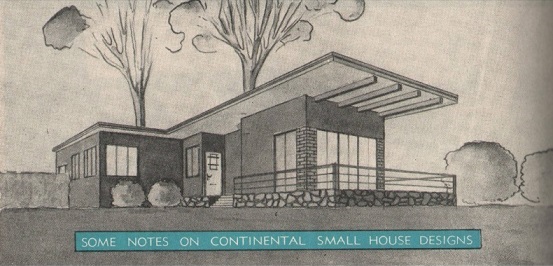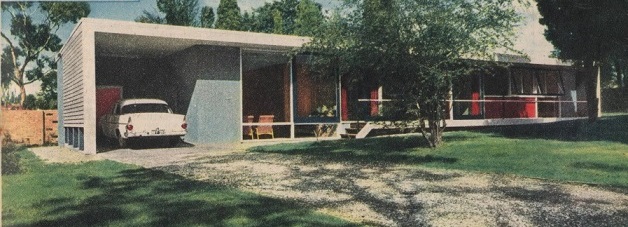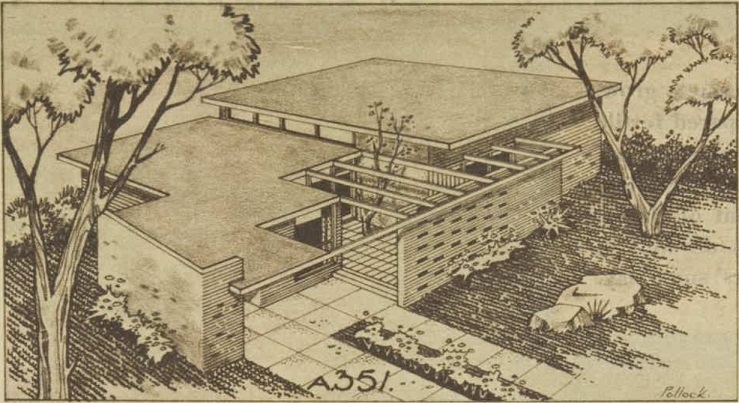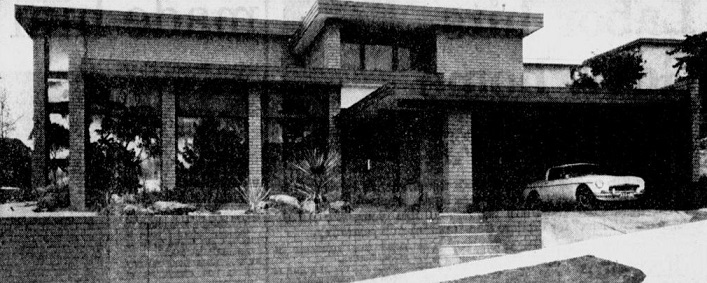Born in Vienna, Austria, on 25 December 1920, Walter Paul Pollock (ne
Pollak) was the son of Rudolf Guenter Pollak and Marianne Pollak Salz.
At the outbreak of the Second
World War, he fled to England, where he worked as a farmer in
Sussex before being apprehended as an enemy alien in May 1940.
Along with more than 2,000 other refugees similarly
apprehended (including furniture designer Fred Lowen and
Bauhaus-trained artist Ludwig Hirschfeldt-Mack), Walter Pollak was sent
to Australia aboard the Dunera. Arriving
in Sydney, he was detained in internment camps at Tatura, Orange and
Hay before being released in March 1942. Settling in
Melbourne, he commenced his architectural studies at the
University of Melbourne. Evidently, the young man had already gained some professional experience whilst still living in Austria as, in 1945, the Australian Home Beautiful
published illustrations of a design that he had prepared for "a small
residence built in Europe in the years immediately preceding the
outbreak of War".
Naturalised in 1946 (after which he anglicised the spelling of his surname), Pollock graduated in May 1950, receiving first-class honours in six out of seven subjects. His fellow graduates that year included such up-and-coming names as Donald Bailey, Don Fulton, Hans Lorraine, Stewart Handasyde, Brian O'Connor and Phyllis Slater (later Mrs John Murphy). Registered as an architect by the end of the year, Pollock initially found employment in the drawing office of the Melbourne Metropolitan Board of Works (MMBW). By the mid-1950s, Pollock was working in association with architect Kenneth McDonald (whom he had studied with at university) before establishing his own private practice around 1959.
Pollock's two best-known projects were houses that he designed for his own family. The first, built in Heidelberg in 1959, was located on part of a former cemetery, and the human remains had to be relocated elsewhere prior to construction. Designed in the hard-edged modernist style typical of European-trained emigre architects, the flat-roofed glass-walled residence appeared in the Australian Home Beautiful in 1961. A decade later, Pollock designed and built a new house in Toorak, which was similarly flat-roofed with full-height windows, albeit this time with a stepped roofline, courtyard plan, face brickwork and landscaped setting, reflecting the more relaxed modernist style of the early 1970s.
Walter Pollock died in September 2010 at the age of 89 years.
Naturalised in 1946 (after which he anglicised the spelling of his surname), Pollock graduated in May 1950, receiving first-class honours in six out of seven subjects. His fellow graduates that year included such up-and-coming names as Donald Bailey, Don Fulton, Hans Lorraine, Stewart Handasyde, Brian O'Connor and Phyllis Slater (later Mrs John Murphy). Registered as an architect by the end of the year, Pollock initially found employment in the drawing office of the Melbourne Metropolitan Board of Works (MMBW). By the mid-1950s, Pollock was working in association with architect Kenneth McDonald (whom he had studied with at university) before establishing his own private practice around 1959.
Pollock's two best-known projects were houses that he designed for his own family. The first, built in Heidelberg in 1959, was located on part of a former cemetery, and the human remains had to be relocated elsewhere prior to construction. Designed in the hard-edged modernist style typical of European-trained emigre architects, the flat-roofed glass-walled residence appeared in the Australian Home Beautiful in 1961. A decade later, Pollock designed and built a new house in Toorak, which was similarly flat-roofed with full-height windows, albeit this time with a stepped roofline, courtyard plan, face brickwork and landscaped setting, reflecting the more relaxed modernist style of the early 1970s.
Walter Pollock died in September 2010 at the age of 89 years.
Select List of Projects
| 1954 1959 1959 1960 1962 1966 1968 1971 1972 | Factory for Kingsley Insulation Pty Ltd, North Road, Oakleigh East Residence for self, 193 Hawdon Street, Heidelberg Residence for H Segal, 7 Bernard Street, Balwyn North Plan No A351 for the Australian Women's Weekly Home Planning Service Headquarters for Waterside Workers' Federation, Flinders Street, Melbourne Flats for Alberto Heights Pty Ltd, Albert Street, East Melbourne Residence, 15 Farmer Street, Brighton East Office building for Advertising Associates, 164 Albert Road, South Melbourne Factory for Hoescht Australia Ltd Residence for self, 1a Grong Grong Court, Toorak |
 | |
| Design for house in Austria by Walter Pollak (c.1939) |
 | |
| Walter Pollock's own house in Heidelberg (1957) |
 | |
| House No A351 for AWW Home Planning Service (1959) |
 | |
| Walter Pollock's own house in Toorak (1972) |
